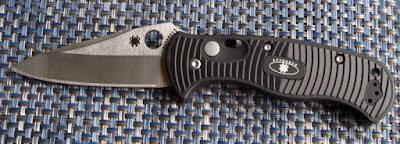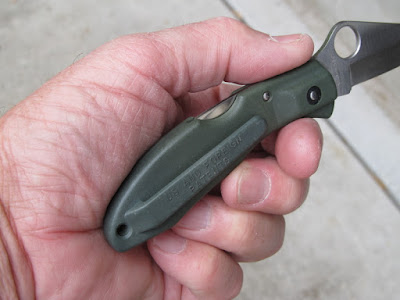In no particular order:
1: Benchmade Griptilian
It was a Christmas present from Karen and I’ve always liked the shape and feel of the Griptilian. The 3.5 inch blades is 154CM steel and it sports what might be considered Benchmade’s most distinguishing feature, the Axis Lock.
2: Twerp by Phil Booth
The sub-2 inch blade is anchored between steel liners with a moon glow plastic spacer. Moon glow has quantum mechanical forbidden energy transitions. I just love that. Coming off the lanyard hole is a small noose, but unfortunately it is a 12 turn and not the traditional 13 turns of lynchings everywhere.
3: Kershaw ET
It is one of the strangest knives I’ve seen or owned. While the design is alien, ET really stands for External Toggle. It was Knife Magazine’s 2005 winner for the “Most Innovative American Design.” Also the scariest. Opening the knife is not for the timid; if the blade doesn’t have sufficient momentum it will stall half-way open and close regardless of what you have in the way. It came with a CD to show you how to open it. Now that’s scary!
4: Spyderco Citadel
It was first automatic knife from Spyderco I heard of. In fact they often denied they made autos. Sal didn’t like ‘em and the violence he associated with them. They would make them when a government organization requested them, but as soon as the overrun was sold that was the end. The Citadel sports a 3.25 inch blade of CPM S30V steel. Sal is getting on in age and his son, Eric seems to be more involved with the company and more states are legalizing automatic knives, so we’ll see what happens. I was assured at the last Blade Show (2017) their policy on autos would remain the same. Like they would tell me.
5: Buck Lighting II
I like the look of the mottled green aluminum handle and the ease of one hand opening.
The 420HC steel blade is 3 inches long and despite the tip down carry, I bought a second in all tactical black.
6: Blackjack’s Mamba
I bought this from the original Blackjack Company. I don’t know what speaks to me, the 3 inch curved blade, the shapely handle or the cool-dagger-in-cards logo, but I had to have one. Maybe its fixed blade big brother convinced me to buy the folder. That’s a story for another time.
7: Spyderco Delica
My first of many Delicas was a green plastic clip made in Seki City, Japan. The blade doesn’t bear the Spyderco trademark. The type of steel wasn’t stamped into the blade and remains an unknown.
I was drawn to the ease of one handed opening, a clip to make it easy to find and of course the lock. It was the beginning of the tactical blade movement and cops were picking up fast on Delicas and its big brother, Endura. Pronounce it ‘dee-leak-a’ and you’ll get a grin out of me every time.
8: Schatt and Morgan
This is a red bone jigged slimline Trapper made by Queen. It’s a non-locking folder, typically called a slip-joint. The American history of slip joints is an incestualized weave of father, brothers and uncles, buying, selling and taking over names and designs. Even today you’ll find company X making knives for company Y. Raymond gave me this knife. He wasn’t young when I met him and he used to come by my table and we would talk blades. Later he’d sit behind the table catching his breath and regathering his stamina before finishing the show. He died on a New Year’s day and now I have this knife to remember him by and that makes me smile.
9: Gerber’s Paul Knife
Yeah, it’s not the original Paul Knife, but it’s still pretty damn cool. Gerber was, (and still is) owned by FISKERS, an English company that apparently knew nothing about America or American knives. The blade is a 2.5 inch-long piece of 400 series stainless. I read it was originally designed for ranch hands who needed a folding knife that could open one-handed while riding a horse.
10: Spyderco Howard Viele
There are few of us that don’t need a dress knife. The Viele, with its elegant blade and lines fills that requirement for me. It’s not a perfect knife; the opening hole is small and hard to access and it’s almost impossible to open left handed. The blade is 3.5 inches of AUS-8 steel. I’ve had it for over 20 years and it still reminds me of Connery’s Bond standing at a roulette wheel.
11: Benchmade Mini-DeJavoo
It’s a Bob Lum design sporting 3.25 inches of S30V steel inside steel lined scales of black, cloth micarta. It is a liner lock and its good looks give it an everyman’s elegance. It’s set-up for left hand carry and despite the fact it’s carried tip down, I use it for my left hand dress knife.
12: Spyderco Chinese Folder
This Bob Lum designed knife has a special spot in my heart. This was the knife I published my first article about. It also had an early innovation, the clip was reversible so you could carry right side, tip up or down.
The Chinese green curved handle makes the knife feel like an extension of my hand. I liked it so much I bought a second one in a steely gray Spyderco calls blue. I have these as my back-up formal wear knives.
Luckly number 13: Gerber Multi-Plier 600
My Father left me many things, mostly memories, but I found a Gerber multi-plier and the belt case in his salt-water tackle box. When I did community theatre in the 80s, the union stage hands were crazy for Gerber multi-tools. You could depress the locking button with one hand and the tool would open. This was invaluable when you were on an the last wrung of an A-frame extension ladder 35 feet in the air hanging on to a flood light with one hand and needing to loosen a bolt with the other. It took me a while to erase the rust and oil it up, but it has straight and serrated blades as well as screwdrivers and the all-important coffee can and beer bottle openers. Most importantly, it was my Dad’s.
Could I have found more knives?
I have one with scales composed of clear epoxy resin filled with eggshells. Eggshells are a semipermeable membrane made of calcium carbonate but not, I believe, the common calcite. It’s a biological form called aragonite, a different crystal arrangement. That is just too cool!
I have a fixed blade from a day long bonding trip with my new in-laws that I purchased to let them know I’m a little off center.
So yeah, I have other knives that make me smile.
















